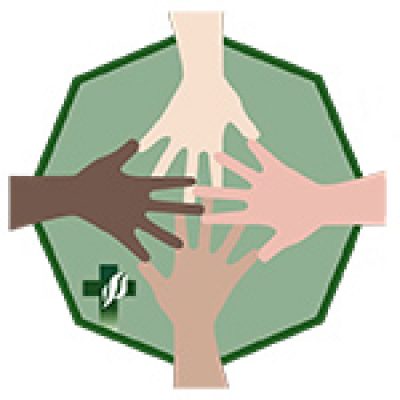September - May: Sunday Discipleship Hour | 9:00 am
Open Office Hours: Monday through Thursday | 9:00 am - 3:00 pm
JEDI Group (Justice, Equity, Diversity, and Inclusion)
JEDI (Justice, Equity, Diversity, and Inclusion) Group
The JEDI (Justice, Equity, Diversity, and Inclusion) Group combines the former Racial Justice Group and the LGBTQ+ Inclusion Task Force. The name change reflects the group’s broader mission to love and serve all people.
Staff Liaison: Pastor Lara Forbes
Meetings: Fourth Wednesday, 7:00 pm
On this webpage….
Current Opportunities JEDI Group Statement Educational Forums Did You Know... Books and Movies Background Information
Current Opportunities
Ongoing
The JEDI Group offers books on Social-Justice/Racism with a display in the Narthex. The books are available for free. You are encouraged to take them home to read and bring back when you are done.
June 19 ~ Juneteenth National Independence Day
This National Holiday commemorates June 19, 1865 when Union troops came to Galveston, Texas and announced the freeing of 250,000 black slaves by executive decree, almost two years after President Lincoln’s Emancipation Proclamation.
June is Pride Month
Every June we celebrate the ongoing struggles of those in the LGBTQIA community to find acceptance, support and inclusion into our broader community. Our joining the Lutheran Reconciling In Christ organization means that we officially recognize and affirm those who have been marginalized by so many in the Christian community.
During the month of June members of the JEDI Group (Justice, Equity, Diversity, Inclusion) hosted a table in the Narthex with information, and collected donations for the national Reconciling In Christ organization to which we belong and have pledged support. Thank you to all who donated!
Please join our work! Contact the church office to get involved.
JEDI Group Statement (Approved at the group’s April 2023 meeting)
Statement:
At Saint Andrew’s we take our mission statement seriously- “to Love and Serve All People”. Saint Andrew’s stands in support of BIPOC (Black, Brown, Indigenous, and other People of Color) and LGBTQIA+ (Lesbian, Gay, Bisexual, Transgender, Queer, Intersex, Asexual, Plus) communities.
Recognizing the systemic racism, racial inequality, homophobia, and transphobia in our community and nation, we acknowledge that we cannot remain silent, nor can we sit idly by. Remaining silent only contributes to injustice.
Learn More by Viewing These Discipleship Hour Forums
- April 14, 2024 | Film Discussion ~ Join us to watch and discuss “The Barber of Little Rock: One Man’s Fight to Close the Racial Wealth Gap.” This documentary film by John Hoffman and Christine Turner follows Arlo Washington as he helps members of his community escape the hazards of banking while Black.
- January 7 and 14, 2024 | Film Discussion ~ we watched, learned from, and discussed “Native Nations: Standing Together for Civil Rights”, a historical documentary of the Indian civil rights movement of the 1970s and 1980s as viewed through the relationship between the Indian people on and off the reservation and the Lutheran churches. This film provides a different perspective on the civil rights movement.
- March 19, 2023 | Film Discussion ~ we watched and discussed the film “Roosevelt High School: Beyond Black & White”, a documentary about race and education based on the experiences of Seattle’s Roosevelt High School yesterday and today
- October 16, 2022 | “A Noose: The Meaning, Horror, and History” ~ we delved into the subject of and lead meaningful discussion around the historical context of noose incidents across the U.S. and in our local communities, and the anti-racist work we are called to do in order to heal from and prevent further racially-motivated harassment and threats. A list of resources used for the presentation is on the page with the recording.
- June 12, 2022 | “Juneteenth” ~ we learned about Juneteenth and our place with this National Holiday.
- February 13, 2022 | “Japanese-American WWII Incarceration” ~ a look at what we were taught at school about these “Japanese Internment Camps”, and listened with compassionate hearts to the testimonies of survivors.
- November 7, 2021 | “Examining Native American Justice” ~ an exploration of Native American Justice and a look at the history of the Fish Wars
- October 17, 2021 | “LGBTQ+ Inclusion” ~ a review of the steps Saint Andrew’s has already taken and presentation and discussion of the proposed Statement of Inclusion
- May 16, 2021 | We discussed “Who is Our Neighbor?” and specific actions we can take (updated November 2022)
- April 18, 2021 | “LGBTQ+ Reconciliation: Speakers Bureau” ~ this Forum featured people from the LGBTQ+ community and those whose congregations have been through the Reconciling in Christ (RIC) process.
- March 7, 2021 | “What the Bible Does and Does Not Say About LGBTQ+” ~ an examination of Biblical and theological perspectives.
- February 28, 2021 | “Racial Justice” ~ The Racial Justice Group shared why this work is important, why the group was created, and what our goals are.
- February 14, 2021 | “Love is Love” ~ a brief history and insight into the LGBTQ+ community and the long battle for civil rights. Notes from February 14 Forum
- September 27, 2020 | “Introduction to Reconciling in Christ” ~ an introduction to the ELCA’s program of Reconciling in Christ and a broad overview of the process to become a Reconciled in Christ congregation.
Did You Know…
…April is Arab American Heritage Month!
In 2022, President Biden became the first U.S. President to declare April as Arab American Heritage Month. Notable Arab Americans include cofounder of Apple Inc. Steve Jobs; football star Doug Flutie; Candy Lightner, creator of Mothers Against Drunk Driving; singer, dancer, and choreographer Paula Abdul; Dr. Mona Hanna-Attisha, the whistleblower of the Flint Water Crisis; and political leader Dina Habib Powell. The United States is home to more than 3.5 million Arab Americans representing a diverse array of backgrounds, cultures and traditions.
The Smithsonian’s National Museum of American History has a collection of oral histories, archival materials, and artifacts dedicated to sharing the story of Arab American immigrants from Syria and Lebanon. You can learn more about this collection by visiting the link https://www.si.edu/spotlight/arab-american
…Kwanzaa is a celebration that starts December 26th each year
Kwanzaa is a celebration that starts December 26th each year. It is celebrated by the African American and Pan-Africa community mostly in the United States. Started in 1966 as a response to the Watts riots, founder Ron Karenga wanted to give the Black community a holiday to celebrate themselves and their community. The seven principle that are celebrated are Umoja (Unity), Kujichagulia (Self-Determination), Ujima (Collective Work and Responsibility), Ujamaa (Cooperative Economics), Nia (Purpose), Kuumba (Creativity), and Imani (Faith) expressed in the Swahili language as one of the most widely spoken languages in Africa. Celebrations happen daily for seven days with the focus on a different principle each day. Kwanzaa is not a religious holiday and is celebrated by African American and Pan-Africa community members of all religions.
For more information, please visit the National Museum of African American History & Culture’s website here: https://nmaahc.si.edu/explore/initiatives/kwanzaa
…Indigenous People’s Day in 2023 is October 9
Indigenous People’s Day has been celebrated annually since 1992 on the 2nd Monday in October, the same day as Columbus Day. That’s not an accident. Momentum began at the 1977 International Conference on Discrimination Against Indigenous Populations sponsored by the U.N. That first 1992 observance was declared by the Berkeley, California City Council, and now by more than 130 cities.
But did you know that today, it is only celebrated by 14 states plus D.C.? Washington is not on the list; it is observed here by the tribes. There are also a variety of Native American Day celebrations in different states and locales, observed in September and November. The UN holiday International Day of the World’s Indigenous People is celebrated on August 9.
Here are some ways to recognize the holiday in our community:
- Write to President Biden in support of more funding of our WA Missing and Murdered Indigenous Women law enforcement program, https://www.cantwell.senate.gov/news/press-releases/cantwell-asks-biden-for-more-federal-resources-to-combat-was-missing-and-murdered-indigenous-women-and-people-crisis
- Contact your state legislators and ask them to pass the 2020 resolution recognizing Indigenous People’s Day in Washington.
- Attend a celebration. Daybreak Star Indian Cultural Center, https://unitedindians.org/event/indigenous-peoples-day-2023/
- Follow news on our state’s tribes. Washington Tribes website online newsletter, has lots of interesting content, https://www.washingtontribes.org/newsletter-archive/.
- Donate to a nonprofit supporting tribal interests like UW’s Intellectual House, https://www.washington.edu/omad/intellectual-house/, or Diversity & Inclusion Fund, https://www.washington.edu/omad/advancement/.
- Check out the informative content on National Today’s Indigenous People’s Day web page, https://nationaltoday.com/indigenous-peoples-day/.
Read articles or a book on the impact of colonialization on indigenous tribes. Stop by the Saint Andrew’s JEDI table in the Narthex and borrow one of our books on indigenous peoples or check out the King County Library System list 8 Books About Pacific Northwest Native Americans, https://kcls.bibliocommons.com/list/share/308506797/1077493658.
…Hispanic Heritage Month is September 15 to October 15
Each year, Americans observe National Hispanic Heritage Month from September 15 to October 15 by celebrating the histories, cultures and contributions of American citizens whose ancestors came from Spain, Mexico, the Caribbean, and Central and South America.
The observation started in 1968 as Hispanic Heritage Week under President Lyndon Johnson and was expanded by President Ronald Reagan in 1988 to cover a 30-day period starting on September 15 and ending on October 15. It was enacted into law on August 17, 1988, on the approval of Public Law 100-402.
The day of September 15 is significant because it is the anniversary of independence for Latin American countries Costa Rica, El Salvador, Guatemala, Honduras, and Nicaragua. In addition, Mexico and Chile celebrate their independence days on September 16 and September18, respectively. Also, Columbus Day or Día de la Raza, which is October 12, falls within this 30 day period.
Information provided by https://www.hispanicheritagemonth.gov/ .
…the original language of the Puget Sound region was Lushootseed
The land acknowledgment that Saint Andrew’s uses to respect and honor the Indigenous Peoples of the land where our church is located identifies them as the Duwamish and Coast Salish people.
“We, at Saint Andrew’s Lutheran Church, acknowledge that in this space we are on the traditional lands of the Duwamish and Coast Salish people. A people that are still here, continuing to honor and bring to light their ancestral heritage.”
These people and those throughout the Puget Sound region spoke a dialect of the Lushootseed language. These people and their language are being recognized in a number of ways and places around the region. Four of the Port of Seattle’s parks have been renamed using the Lushootseed language. At Renton’s Gene Coulon Park, displays on Bird Island include wildlife names in the Lushootseed language including pronunciation information. The Lushootseed language uses its own alphabet which makes it difficult to even try to pronounce the words.
The former Terminal 105 Park is now ![]() Village Park & Shoreline Habitat.
Village Park & Shoreline Habitat.
(“t-oo-ah-lal-too-wx”; Herring’s House).
The former Terminal 107 Park is now ![]() Village Park & Shoreline Habitat.
Village Park & Shoreline Habitat.
(“ha-ah-poos”).
For more information about these park names see: https://westseattleblog.com/2020/10/followup-here-are-the-new-names-for-port-of-seattles-6-duwamish-river-parks/.
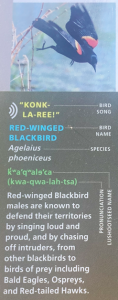 The next time you visit Coulon Park, take the boardwalk to Bird Island at the southwest corner of the park. From here spot the wildlife and note the information signs that include names in the Lushootseed language. See the example.
The next time you visit Coulon Park, take the boardwalk to Bird Island at the southwest corner of the park. From here spot the wildlife and note the information signs that include names in the Lushootseed language. See the example.
If you are curious, you can learn three simple phases at this website: https://tulaliplushootseed.com/.

Book and Movie Suggestions
Book Suggestions:
Killers of the Flower Moon by David Grann
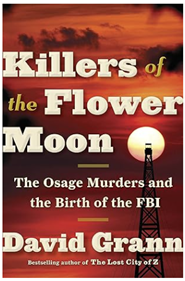 Killers of the Flower Moon is a true-life murder mystery about one of the most monstrous crimes in American history. In the 1920s, the richest people per capita in the world were members of the Osage Nation in Oklahoma. After oil was discovered beneath their land, the Osage rode in chauffeured automobiles, built mansions, and sent their children to study in Europe.
Killers of the Flower Moon is a true-life murder mystery about one of the most monstrous crimes in American history. In the 1920s, the richest people per capita in the world were members of the Osage Nation in Oklahoma. After oil was discovered beneath their land, the Osage rode in chauffeured automobiles, built mansions, and sent their children to study in Europe.
Then, one by one, the Osage began to be killed off. The family of an Osage woman, Mollie Burkhart, became a prime target. One of her relatives was shot. Another was poisoned. And it was just the beginning, as more and more Osage were dying under mysterious circumstances, and many of those who dared to investigate the killings were themselves murdered.
As the death toll rose, the newly created FBI took up the case, and the young director, J. Edgar Hoover, turned to a former Texas Ranger named Tom White to try to unravel the mystery. White put together an undercover team, including a Native American agent who infiltrated the region, and together with the Osage began to expose one of the most chilling conspiracies in American history.
This is a captivating story. It was hard to put down. I was familiar with the horrible way that our government has treated the indigenous people. I wasn’t familiar with the Osage people, who were driven to some of the most unusable and undesirable land in Oklahoma. At least, until oil was discovered under that land. I was surprised (appalled) by the way the Osage people were treated by the government (declared unfit to handle their own finances), the courts, law enforcement and their “friends”. The story is told from the perspective of two individuals, Mollie Burkhart, an Osage woman, and Tom White, an FBI investigator. I found this a very good book, both as a murder mystery and history of the Osage people. A movie of the same title, based on this book, was released in October. I haven’t seen it yet, so I can’t recommend it, but understand that it is very good despite its length (3 hours 26 minutes). I definitely recommend this book – Dick S
Built from the Fire by Victor Luckerson
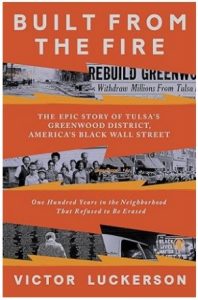 Built from the Fire tells the story of an aspirant black neighborhood that, like so many others, has long been buffeted by racist government policies. It relates the 1921 Tulsa Race Massacre that was one of the most brutal acts of racist violence in U.S. history, a ruthless attempt to smother a spark of black independence. It continues through a hundred years of a neighborhood that refused, more than once, to be erased.
Built from the Fire tells the story of an aspirant black neighborhood that, like so many others, has long been buffeted by racist government policies. It relates the 1921 Tulsa Race Massacre that was one of the most brutal acts of racist violence in U.S. history, a ruthless attempt to smother a spark of black independence. It continues through a hundred years of a neighborhood that refused, more than once, to be erased.
Before reading this book, I had heard a little about the Greenwood District of Tulsa (known as Black Wall Street) and was intrigued when I saw this book described in the Seattle Times. I enjoy reading history but prefer it in the story of people (biographies). Covering 100 years of the Greenwood community, it relates the story of three generations from Ed Goodwin, who was in high school during the 1921 massacre, to his granddaughter Regina who represented the neighborhood in the Oklahoma state legislature. I was amazed and inspired by the resilience and determination of the people in this neighborhood. This in spite of the government’s efforts to “improve” cities and communities. A very good book ~ Dick S
Empire of the Summer Moon by S. C. Gwynne
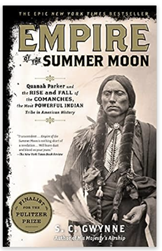 Empire of the Summer Moon is a vivid historical account of the forty-year battle between Comanche Indians and white settlers for control of the American West. It centers on Quanah, the greatest Comanche chief. The book spans two astonishing stories. The first traces the rise and fall of the Comanches, the most powerful Indian tribe in American history. The second entails one of the most remarkable narratives ever to come out of the Old West: the epic saga of the pioneer woman Cynthia Ann Parker and her mixed-blood son Quanah, who became the last and greatest chief of the Comanches.
Empire of the Summer Moon is a vivid historical account of the forty-year battle between Comanche Indians and white settlers for control of the American West. It centers on Quanah, the greatest Comanche chief. The book spans two astonishing stories. The first traces the rise and fall of the Comanches, the most powerful Indian tribe in American history. The second entails one of the most remarkable narratives ever to come out of the Old West: the epic saga of the pioneer woman Cynthia Ann Parker and her mixed-blood son Quanah, who became the last and greatest chief of the Comanches.
Uncomfortable Conversations with a Black Man by Emmanuel Acho
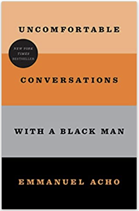 In Uncomfortable Conversations With a Black Man, Acho takes on all the questions, large and small, insensitive and taboo, many white Americans are afraid to ask―yet which all Americans need the answers to, now more than ever. With the same open-hearted generosity that has made his video series a phenomenon, Acho explains the vital core of such fraught concepts as white privilege, cultural appropriation, and “reverse racism.” In his own words, he provides a space of compassion and understanding in a discussion that can lack both. He asks only for the reader’s curiosity―but along the way, he will galvanize all of us to join the antiracist fight.
In Uncomfortable Conversations With a Black Man, Acho takes on all the questions, large and small, insensitive and taboo, many white Americans are afraid to ask―yet which all Americans need the answers to, now more than ever. With the same open-hearted generosity that has made his video series a phenomenon, Acho explains the vital core of such fraught concepts as white privilege, cultural appropriation, and “reverse racism.” In his own words, he provides a space of compassion and understanding in a discussion that can lack both. He asks only for the reader’s curiosity―but along the way, he will galvanize all of us to join the antiracist fight.
Movie and TV Suggestions:
Little Mosque on the Prairie: “Small town Canada with a little Muslim twist” (TV)
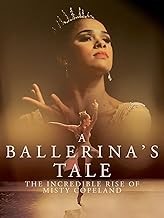 Little Mosque on the Prairie is a 2007 Canadian television sitcom that focuses on a small Muslim community in the fictional town of Mercy, with a diverse cast of Muslim and non-Muslim characters. Muslim show creator Zarqa Nawaz (ZAR-kuh NAH-waz) wrote the sitcom based on the premise of a Canadian mosque recruiting a young, progressive imam (i.e. Muslim priest). She also used some of her and her family and friends’ experiences as Muslims as the basis for some episode plots, including one where conservative mosque members called for a barrier separating men and women during worship, to the shagrin of more progressive female members. The show was so successful it ran for six (6) seasons, and was picked up by online streaming service Hulu in 2012. The main cast includes Zaib Shaikh, Sitara Hewitt, Carlo Rota, Debra McGrath, Manoj Sood, and Sheila McCarthy, and guest actors include Who’s Line Is It Anyway’s Colin Mochrie and Daily Show’s Samantha Bee.
Little Mosque on the Prairie is a 2007 Canadian television sitcom that focuses on a small Muslim community in the fictional town of Mercy, with a diverse cast of Muslim and non-Muslim characters. Muslim show creator Zarqa Nawaz (ZAR-kuh NAH-waz) wrote the sitcom based on the premise of a Canadian mosque recruiting a young, progressive imam (i.e. Muslim priest). She also used some of her and her family and friends’ experiences as Muslims as the basis for some episode plots, including one where conservative mosque members called for a barrier separating men and women during worship, to the shagrin of more progressive female members. The show was so successful it ran for six (6) seasons, and was picked up by online streaming service Hulu in 2012. The main cast includes Zaib Shaikh, Sitara Hewitt, Carlo Rota, Debra McGrath, Manoj Sood, and Sheila McCarthy, and guest actors include Who’s Line Is It Anyway’s Colin Mochrie and Daily Show’s Samantha Bee.
I was recommended this show by a friend of mine who is Muslim, who told me she loved it and hoped that it might help non-Muslim people understand more about Islam, since she was tired of being asked to educate everyone about her culture and faith so often. Sure enough, just watching the first episode, I realized that while I was watching what was essentially just another comedic 2000’s show, I was also learning things I never knew I never knew.
I suggest you watch the pilot episode, “Little Mosque”, where we are introduced to the cast of diverse characters for the first time. The show is wonderfully crafted in a way to showcase just how different people are within the Muslim as well as the non-Muslim communities. You see conservative Muslims and non-Muslims, you see liberal Muslims and non-Muslims, and every point on the political compass in between. Diverse cast aside, I love that we have a light-hearted, intimate look into the everyday lives of Muslims. It seems that most representations we see of Muslims in the media are only when the plots are dramatic, sad, or violent. Shows like Little Mosque on the Prairie help remind our brains that Muslims are just as diverse and normal as you and me.
Even if the show doesn’t get into the “difficult conversations” as much as some other media suggestions we at JEDI Group have made, I think that using media to help us adjust our worldview to help see those different than us as not so different after all, is very, very important.
The only complaint I have is, the show does have plenty of 2000’s sitcom humor, which can either hit or miss depending on your preferences; but even then, if a joke doesn’t land, the show moves onto the next joke right after, so it didn’t ruin my enjoyment too much. ~ Maria H
A Ballerina’s Tale (Movie)
 A Ballerina’s Tale shows the struggles and successes of Misty Copeland, the first Black principal dancer of the American Ballet Theatre. The film explores themes around race as well as body image as it walks through Copeland’s dance history. While the film does not dive into her personal life, there is a great segment that explores Copeland’s role model Raven Wilkinson and their bond being two barrier-breaking performers.
A Ballerina’s Tale shows the struggles and successes of Misty Copeland, the first Black principal dancer of the American Ballet Theatre. The film explores themes around race as well as body image as it walks through Copeland’s dance history. While the film does not dive into her personal life, there is a great segment that explores Copeland’s role model Raven Wilkinson and their bond being two barrier-breaking performers.
I love finding films that highlight female athletes. Dance was never part of my world growing up (way too clumsy!), but I love how it is not only a medium for physical exercise, but also personal expression. It was great to learn more about Copeland’s ambitions and her hurdles. Becoming a mainstream artist is a struggle to begin with – and it was even more humbling to learn about her personal challenges while pursuing her dreams. ~ Becca P
A Time to Kill (Movie)
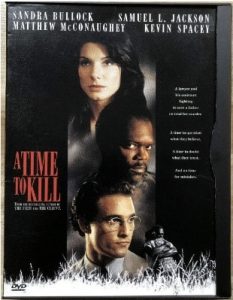 In Canton, Mississippi, a fearless young lawyer and his assistant defend a black man accused of murdering two white men who tortured and raped his ten-year-old daughter, inciting violent retribution and revenge from the Ku Klux Klan.
In Canton, Mississippi, a fearless young lawyer and his assistant defend a black man accused of murdering two white men who tortured and raped his ten-year-old daughter, inciting violent retribution and revenge from the Ku Klux Klan.
John Grisham described the book as very autobiographical. The young attorney is basically him. The drama is based on a case he witnessed in 1984, from testimony of a 10-year-old rape victim at the De Soto County courthouse in Hernando, Mississippi.
The Black father is on trial for shooting and killing the two white male rapists. Near the end of the trial, the attorney for the father asks the jury to close their eyes while he tells them a story. It is the description of what happened to this little girl. When he finished, he asked them to picture the little girl. Then he said… now imagine she’s white. Shock in the courtroom. But a very important point is made.
The movie is very well done. The way the attorney had the jury close their eyes when he told the story and then dropped the bomb, by having them imagine the little girl was white. That scene stays with me. Very powerful. Very well done ~ Debbie S.
Till (Movie)
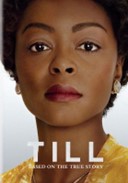 Based on the true story of Mamie Till Mobley’s relentless pursuit of justice for her 14-year-old son, Emmett Till, who, in 1955, was lynched while visiting his cousins in Mississippi. After his lynching, Till embarks on a long journey to seek justice for her murdered son, channeling her grief and anger to a higher cause. In Mamie’s poignant journey of grief turned to action, we see the universal power of a mother’s ability to change the world.
Based on the true story of Mamie Till Mobley’s relentless pursuit of justice for her 14-year-old son, Emmett Till, who, in 1955, was lynched while visiting his cousins in Mississippi. After his lynching, Till embarks on a long journey to seek justice for her murdered son, channeling her grief and anger to a higher cause. In Mamie’s poignant journey of grief turned to action, we see the universal power of a mother’s ability to change the world.
The Hate You Give (Movie)
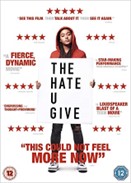 A young black student from a poor neighborhood who attends a prep school in an affluent area finds her uneasy life balance further disrupted when she witnesses her childhood friend being shot by a police officer. Caught in the middle of the subsequent turmoil, she is forced to look inside herself and figure out just where she stands in her young life. Based on a book of the same name by Angie Thomas.
A young black student from a poor neighborhood who attends a prep school in an affluent area finds her uneasy life balance further disrupted when she witnesses her childhood friend being shot by a police officer. Caught in the middle of the subsequent turmoil, she is forced to look inside herself and figure out just where she stands in her young life. Based on a book of the same name by Angie Thomas.
Background Information
For background information, visit these pages:
Racial Justice Group LGBTQ+ Inclusion Task Force
Sunday Worship | 10:00 am
In-Person AND Livestream
September-May: Sunday Discipleship Hour | 9:00 am
Classes for age 2 – adults
Worship Times, Map, and Directions
Saint Andrew’s Lutheran Church
2650 148th Avenue SE
Bellevue, Washington 98007
425-746-2529 phone
425-746-3758 fax
info@SALC.church
Office Hours: 9:00 am – 3:00 pm Monday – Thursday. Closed on legal holidays.
Pages focused on families:
We are an ELCA congregation and part of the Northwest Washington Synod
We are a Reconciling in Christ congregation

Use of content, including images, is prohibited without permission of Saint Andrew's Lutheran Church.


